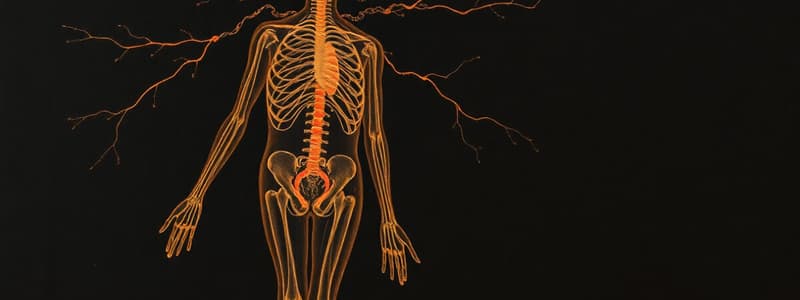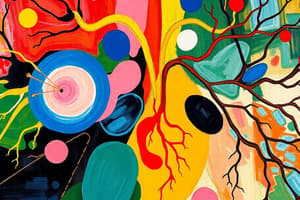Podcast
Questions and Answers
What is the primary effect of Growth Hormone (GH) on the body?
What is the primary effect of Growth Hormone (GH) on the body?
Which of the following conditions is characterized by an excess of Growth Hormone (GH) in children?
Which of the following conditions is characterized by an excess of Growth Hormone (GH) in children?
Which hormone inhibits the production of Growth Hormone (GH)?
Which hormone inhibits the production of Growth Hormone (GH)?
Which of the following is NOT a direct effect of Growth Hormone (GH) on target tissues?
Which of the following is NOT a direct effect of Growth Hormone (GH) on target tissues?
Signup and view all the answers
What is the role of the hypothalamus in the regulation of Growth Hormone (GH) production?
What is the role of the hypothalamus in the regulation of Growth Hormone (GH) production?
Signup and view all the answers
What is the effect of an increased level of a hormone on the target cell, regarding the number of receptors?
What is the effect of an increased level of a hormone on the target cell, regarding the number of receptors?
Signup and view all the answers
Which of the following statements is TRUE about the endocrine system?
Which of the following statements is TRUE about the endocrine system?
Signup and view all the answers
What is the primary role of the hypothalamus in the endocrine system?
What is the primary role of the hypothalamus in the endocrine system?
Signup and view all the answers
Which of the following BEST describes paracrine signaling?
Which of the following BEST describes paracrine signaling?
Signup and view all the answers
Which of the following glands has BOTH endocrine and exocrine functions?
Which of the following glands has BOTH endocrine and exocrine functions?
Signup and view all the answers
Which of these is NOT a type of hormone classification based on biochemical makeup?
Which of these is NOT a type of hormone classification based on biochemical makeup?
Signup and view all the answers
What is the defining characteristic of an endocrine gland?
What is the defining characteristic of an endocrine gland?
Signup and view all the answers
Which of the following BEST describes the relationship between the nervous and endocrine systems?
Which of the following BEST describes the relationship between the nervous and endocrine systems?
Signup and view all the answers
Which type of chemical messenger is responsible for regulating the activities of neighboring cells in a localized area?
Which type of chemical messenger is responsible for regulating the activities of neighboring cells in a localized area?
Signup and view all the answers
Which of the following is NOT a true hormone, but acts as a bio-active lipid with localized effects?
Which of the following is NOT a true hormone, but acts as a bio-active lipid with localized effects?
Signup and view all the answers
Which of the following is a characteristic of steroid hormones?
Which of the following is a characteristic of steroid hormones?
Signup and view all the answers
What is the primary function of leukotrienes?
What is the primary function of leukotrienes?
Signup and view all the answers
Which of the following is NOT a potential effect of a hormone on its target cell?
Which of the following is NOT a potential effect of a hormone on its target cell?
Signup and view all the answers
How do steroid hormones influence their target cells?
How do steroid hormones influence their target cells?
Signup and view all the answers
What is the primary difference between the effects of prostaglandins and leukotrienes?
What is the primary difference between the effects of prostaglandins and leukotrienes?
Signup and view all the answers
What determines the specific effect of a hormone on a target cell?
What determines the specific effect of a hormone on a target cell?
Signup and view all the answers
Which of the following hormones is NOT produced by the gonads?
Which of the following hormones is NOT produced by the gonads?
Signup and view all the answers
Which of the following hormones is produced by the posterior pituitary gland?
Which of the following hormones is produced by the posterior pituitary gland?
Signup and view all the answers
What is the primary function of the infundibulum?
What is the primary function of the infundibulum?
Signup and view all the answers
What is the mechanism of action for hormones secreted by the anterior pituitary gland?
What is the mechanism of action for hormones secreted by the anterior pituitary gland?
Signup and view all the answers
Which of the following is NOT a tropic hormone?
Which of the following is NOT a tropic hormone?
Signup and view all the answers
Which structure is responsible for monitoring the solute concentration of the blood?
Which structure is responsible for monitoring the solute concentration of the blood?
Signup and view all the answers
What is the primary function of Antidiuretic Hormone (ADH)?
What is the primary function of Antidiuretic Hormone (ADH)?
Signup and view all the answers
How is alcohol related to Antidiuretic Hormone (ADH)?
How is alcohol related to Antidiuretic Hormone (ADH)?
Signup and view all the answers
Which of the following statements is true about the relationship between the anterior and posterior pituitary glands?
Which of the following statements is true about the relationship between the anterior and posterior pituitary glands?
Signup and view all the answers
What is a similarity between steroid and non-steroid action?
What is a similarity between steroid and non-steroid action?
Signup and view all the answers
According to the information provided, which mechanism relies on G protein activation?
According to the information provided, which mechanism relies on G protein activation?
Signup and view all the answers
What is the function of cAMP?
What is the function of cAMP?
Signup and view all the answers
Which of the following is NOT directly involved in the PIP-calcium mechanism?
Which of the following is NOT directly involved in the PIP-calcium mechanism?
Signup and view all the answers
How does the steroid hormone/receptor complex initiate protein production?
How does the steroid hormone/receptor complex initiate protein production?
Signup and view all the answers
What is the role of phosphodiesterase in the cAMP mechanism?
What is the role of phosphodiesterase in the cAMP mechanism?
Signup and view all the answers
How does the PIP-calcium mechanism differ from the cAMP mechanism?
How does the PIP-calcium mechanism differ from the cAMP mechanism?
Signup and view all the answers
What is the primary outcome of both the cAMP and PIP-calcium mechanisms?
What is the primary outcome of both the cAMP and PIP-calcium mechanisms?
Signup and view all the answers
Study Notes
Endocrine System Activity Controlling Mechanisms
- Nervous System uses electrical messages and is faster
- Endocrine System utilizes chemical messages and is slower
- Response time: Nervous system is shorter, Endocrine system is longer
- Affected cells/tissues: Nervous system affects excitable tissues (muscles and glands); Endocrine system affects cells with receptors
- Receptors: Each cell has specific receptors; Nervous system doesn't have receptors in the same way
- Interaction: Nervous system can regulate endocrine system activity
Glands
- Exocrine glands: have ducts; produce substances like sweat, saliva, breast milk, digestive juices
- Endocrine glands: lack ducts; release hormones; highly vascularized; related to digestion and sweat glands
Neuroendocrine Link
- There is a strong connection between the nervous and endocrine systems
- The hypothalamus is the primary link between the two systems, and it regulates the endocrine system.
Chemical Messengers
- Hormones: long-distance chemical messengers produced in one part of the body, and have an effect somewhere else in the body
- Autocrine: hormones secreted by a cell that affect the same (that cell)
- Paracrine: local signaling molecules that affect neighboring cells; do not affect their own secretion cells
- Pheromones: chemicals produced by one organism affecting another; often used to attract or repel others
Hormone Classifications
- Amino acid-based (non-steroid): derived from peptides/proteins; water-soluble; receptors are on the outside of the cell
- Steroid: derived from cholesterol; lipid-soluble; receptors inside the cell; produced by gonads and cortex of the adrenal gland
- Eicosanoids: not considered true hormones; released by cell membranes, but with localized effects; bioactive lipids (prostaglandins, leukotrienes); involved in inflammatory and immune responses
Hormone Actions
- Target cells: any cell with a receptor for a particular hormone
- Hormone effect: Changing the permeability of the target cell after the hormone binds
- Potential effects: opening or closing ion channels, stimulating protein synthesis, activating or deactivating enzymes, promoting secretion, stimulating mitosis/cell division
Hormonal Mechanisms
- Amino acid-based: indirect activation; involve G proteins and secondary messengers; receptors on the plasma membrane
- Steroid: direct activation; receptors are inside the nucleus
Steroid Action
- Hormone is secreted by an endocrine gland
- Travels through bloodstream to target cell
- Diffuses through plasma membrane
- Binds with intracellular (nuclear) receptor
- Activated complex acts as a primer, binds to a specific DNA receptor
- Transcription is initiated
- Proteins are translated
Non-Steroid Action
- Cyclic AMP mechanism: hormone binds to a membrane receptor; G protein is activated; adenylate cyclase generates cyclic AMP (cAMP) from ATP; cAMP activates protein kinase; proteins are phosphorylated (activated or deactivated)
- PIP-calcium mechanism: Hormone binds to membrane receptor; G protein is activated; phospholipase splits PIP2 into DAG and IP3; DAG activates protein kinases; IP3 triggers calcium release from the endoplasmic reticulum; Calcium acts as a secondary messenger
Factors Affecting Hormone Action
- Hormone level: higher levels generally yield a greater activity
- Number of receptors: more receptors in the target cell means greater activity
- Receptor affinity: higher affinity hormones mean greater activity
Types of Regulation
- Up-regulation: Increased exposure to a hormone causes an increase in hormone receptors for that hormone, resulting in more activity
- Down-regulation: Continued exposure to a hormone results in a decrease in the number of hormone receptors, reducing activity
Hormone Interactions
- Permissiveness: one hormone needs another hormone to exert its full effect
- Synergism: multiple hormones have similar effects, and the combined effect is more pronounced
- Antagonism: hormones have opposing effects on the target cell
Modes of Endocrine Gland Stimulation
- Humoral: changes in blood chemistry/concentration stimulate endocrine glands
- Neural: Nervous stimulation activates endocrine glands to secrete hormones
- Hormonal: One endocrine gland is activated by hormones produced by a different endocrine gland (tropic hormones)
Endocrine Glands
- Pituitary, thyroid, parathyroid, adrenals, pancreas, gonads (testes/ovaries), pineal, thymus
Pituitary Glands
- Posterior: Composed of neural tissue, an outgrowth of the hypothalamus
- Anterior: Composed of glandular tissue, next to posterior pituitary
Tropic Hormones
- Their target tissues are other endocrine glands
- Cause the production of another hormone
Hormones Secreted by Posterior Pituitary
- Oxytocin: stimulates smooth muscle contraction, involved in childbirth and lactation; also related to sexual arousal and satisfaction
- Antidiuretic Hormone (ADH): regulates water balance; targets kidney tubules to conserve water; prevents urine formation; helps with osmoregulation
Hormones Secreted by Anterior Pituitary
- Growth Hormone (GH): stimulates cell growth and division, protein synthesis, metabolism, and glucose conservation; most important for muscle and bone growth
- Other Anterior Pituitary Hormones: TSH, ACTH, Gonadotropins (FSH, LH), Prolactin, and POMC
Studying That Suits You
Use AI to generate personalized quizzes and flashcards to suit your learning preferences.
Related Documents
Description
Test your understanding of the mechanisms controlling the endocrine and nervous systems. This quiz covers the differences in response time, types of glands, and the neuroendocrine link. Explore how these systems interconnect and influence various bodily functions.




